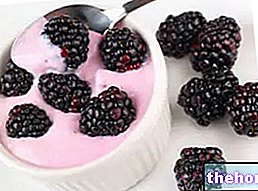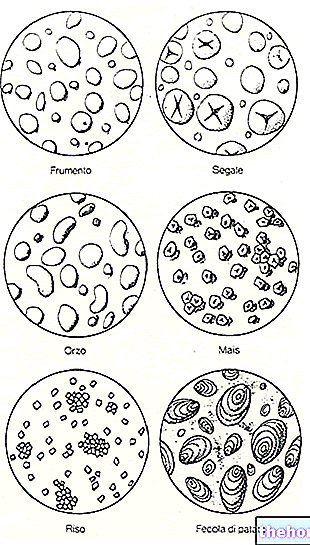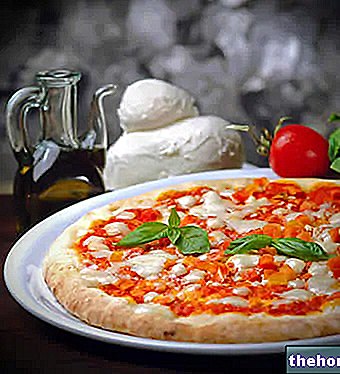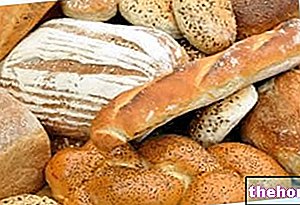Generality
Egg pasta is a basic preparation of Italian cuisine, especially in the Emilia area. It is a simple dough, made from chicken eggs and wheat flour, divided into small regular shapes and intended for cooking with humid heat.

ATTENTION! It is not uncommon for egg pasta to be erroneously called "puff pastry". The misunderstanding arises from the fact that fresh rolled pasta (later on we will see how) acquires the name of sfoia, or browse (from foi or sheet); actually, the puff pastry proper is a TOTALLY different preparation, French, rich in butter, basically egg-free and intended for sweet and savory pastry.
Nutritional Characteristics
From egg pasta, starchy first courses rich in gluten are obtained. The caloric prevalence of egg pasta is therefore attributable to the content of complex carbohydrates. Proteins follow, of greater importance than semolina pasta; finally the fatty acids. The fiber is present in an average quantity but slightly higher than that of semolina. Unlike the latter, the egg one (both fresh and dried) also provides a certain amount of cholesterol.
The energy supply of dried egg pasta is similar (slightly higher) to that of dry semolina pasta. On the other hand, that of fresh egg pasta is more similar to the energy supply of COOKED semolina pasta. Being already strongly hydrated, during cooking, fresh egg pasta does NOT show a significant volumetric growth.
As far as the mineral salts are concerned, egg pasta is distinguished by the greater presence of iron; on the contrary, with regard to vitamins, the equivalent retinol or vitamin A is present (thanks to the carotenoids of the egg).
Variants of Egg Pasta
Obviously, egg pasta can be made using ingredients of the same kind but different from traditional ones. For example, the types of eggs or the yolk / egg white ratio can change: guinea fowl, duck, goose, turkey eggs, more yolk than egg white, more egg white than yolk etc.
It is also possible to change the type of flour used: wholemeal flour, type 1, type 0, durum wheat semolina, etc. The egg pasta can also be made of different colors: red (with the use of tomato paste or beetroot puree), green (with the addition of cooked, squeezed and finely chopped herbs), black with cuttlefish ink, etc.
To flavor the egg pasta just add the desired spice; some types are: saffron, chilli, paprika, pepper, mustard, turmeric etc.
Traditional Egg Pasta Color
For a traditional FRESH egg pasta it is crucial that the eggs are fresh, with an intense orange, almost red yolk. Many readers will wonder how it is possible to understand the color of the yolk before having broken it. There is not! Once, when egg pasta was a customary preparation in the farmhouses of the Po Valley, the zdore (or azdore) knew that to make egg pasta it was necessary to feed laying hens with food (kitchen waste and grains) of red color. It may seem strange, but it works! In fact, the pigment of the egg yolk is due to the presence of pro -vitamin A type carotenoid; it goes without saying that the higher the nutritional content in carotenoids in the hen, the better the pigmentation of the egg. In addition to rotten peppers, spoiled carrots, tomato skins (residues from the preparation of the preserves), melon and watermelon peels, etc., it is advisable to feed laying hens with a part of popcorn corn.
Other Egg Doughs
While tradition teaches above all to "manipulate" egg pasta, the innovative cuisine suggests how to optimize the dough according to the recipe. Let's be clear, from a good egg pasta you can get all the possible dishes that need this base; on the other hand, some technicians have developed some slightly different recipes that lend themselves specifically to some products.
I take this opportunity to report what is described by Michele D "Agostino (cook of the Italian Chefs Federation) in a file produced by consulting the archive of the Ateneo di Cucina Italiana and published on the website www.assocuochibaresi.it.
Basic fresh egg pasta recipe
Ingredients: soft wheat flour type "00" 800g, durum wheat semolina 200g and chicken eggs n ° 10. Some also add a spoonful of extra virgin olive oil but it is not part of the Emilian tradition.
Recipe of fresh egg pasta for ravioli
Ingredients: soft wheat flour type "00" 800g, durum wheat semolina 200g and chicken eggs n ° 10, a tablespoon of extra virgin olive oil and one of white wine vinegar.
Recipe of fresh egg pasta for angel hair
Ingredients: soft wheat flour type "0" 1000g, egg yolks 900g.
Recipe of fresh egg pasta for spaghetti al torchio
Ingredients: soft wheat flour type "00" 500g, durum wheat semolina 500g and chicken eggs 350g.
Recipe of fresh egg pasta with pepper
Ingredients: soft wheat flour type "0" 1000g, egg yolk 80g, whole eggs 200g and pasteurized pepper 100g.
Recipe of fresh egg pasta with cuttlefish ink
Ingredients: soft wheat flour type "00" 1000g, egg yolk 100g, whole eggs 250g and squid ink 50g.
Fresh green egg pasta recipe
Ingredients: soft wheat flour type "00" 1000g, 200g chicken eggs, 100g chlorophyll and a tablespoon of extra virgin olive oil.
Recipe of fresh red egg pasta
Ingredients: soft wheat flour type "00" 500g, durum wheat semolina 60g, egg yolk 100g, whole egg n ° 1, 200g beetroot puree and a tablespoon of extra virgin olive oil.
Saffron egg pasta recipe
Ingredients: soft wheat flour type "00" 800g, durum wheat semolina 200g, whole chicken eggs 400g, diluted n ° 4 saffron sachets.
Recipe of egg pasta with truffles
Ingredients: soft wheat flour type "00" 1000g, whole eggs 350g, truffle puree 10g, truffle oil 1 tablespoon, water to taste.
Process of Egg Pasta
The procedure for preparing FRESH egg pasta is simple, but it is not easy! In practice, the various processing steps are quite clear but their correct execution is not something for everyone.
The tools needed are: pastry board, fork or small whisk and scraper.
It starts by forming a fountain (like a "volcano") with the flour. Inside, the eggs are broken, then beaten with a fork or whisk. At this point, always with a fork or whisk, the flour is gradually incorporated from the edges of the fountain until the consistency of the central dough is so high as to make it impossible to continue. Now, put away the fork or whisk and start using your hands; at first all the flour is incorporated by mixing the dough (still raw), then, with "elbow grease" and using the scraper, everything is kneaded, taking care NOT to leave pieces of dough attached to the pastry board or on the hands . Continue to manipulate the egg pasta until the mixture is smooth and uniform; finally, it is placed in the fridge to rest for at least 30 ".
NB: The mixture of flour (soft wheat and durum wheat) determines the hardness and consistency of the pasta. The more durum wheat is used, the greater the strength (physical and heat) and the difficulty of kneading.
Dry egg pasta is a prerogative of industrial processing; in this case, in addition to the use of freeze-dried and rehydrated eggs, the method of dehydration with cold air is applied.
Fresh homemade pasta - yellow pasta, green pasta and black pasta - how to prepare it and how to cook it
Problems with playing the video? Reload the video from youtube.
- Go to the Video Page
- Go to the Video Recipes Section
- Watch the video on youtube
Other Tips for Egg Pasta
As anticipated, egg pasta is a dough aimed at the packaging of first courses. First of all, it is necessary to distinguish the types of pasta into: simple egg pasta (fresh or dried) and filled egg pasta. cooking times and the physical characteristics of food depend essentially on 3 factors: the presence of gluten in the flour (elasticity), albumins in the egg white (gelation) and lecithins in the yolk (emulsion). By significantly reducing one of these 3 factors, for example for:
- Making a gluten-free / low-gluten pasta (with or without wheat flour)
- Making a low cholesterol pasta (with or without yolk)
- Produce a very yellow paste with an intense flavor (with or without egg white)
will be altered: the toughness in the processing, the times and the resistance in cooking.
That said, egg pasta can be used for: soupy pastas (maltagliati, tagliolini, etc.), sautéed pasta (tagliatelle, pappardelle, slates, spaghetti alla chitarra or al torchio, etc.) and stuffed pasta (ravioli, candies, agnolotti , cappelletti, tortellini, tortelli, cappellacci, cannelloni and lasagna).
Be careful though; it is necessary to remember that, in the preparation of any recipe, egg pasta is always the ingredient with the shortest cooking time; this means that both the accompanying sauce, and certain sauces (ragù, béchamel etc.), and the filling (of stuffed pasta), always require pre-processing with heat (except for processed foods, such as ricotta); this allows not to overcook the pasta during the last steps of the procedure.
Other Cereals and Derivatives Amaranth Wheat starch Corn starch Rice starch Modified starch Oat starch Bulgur Whole grains Corn Flakes Crackers Oat bran Bran Cus cus Amaranth flour Oat flour Buratto flour Spelled flour Buckwheat flour Corn flour Corn flour Millet Barley flour Quinoa flour Small spelled flour (Enkir) Rice flour Rye flour Sorghum flour Flour and semolina Whole wheat flour Manitoba flour Pizza flour Spelled Rusks Focaccia Nuts Wheat or wheat Wheat germ Burnt wheat Buckwheat Breadsticks Oat milk Rice milk Corn Maizena Malt Millet Muesli Barley Stale bread Unleavened bread and Pita Bread Carasau bread Egg pasta Rice pasta Wholemeal pasta Piadina Small spelled Pizza Pop corn Baked goods Quinoa Rice Basmati rice Converted rice White rice Rice Wholemeal Parboiled Rice Puffed Rice Venus Rice Rye and Horned Rye Semolina Semolina Sorghum Spaghetti Spelled Teff Tigelle Triticale OTHER ARTICLES CEREALS AND DERIVATIVES Categories Food Alcoholics Meat Cereals and derivatives Sweeteners Sweets Offal Fruit Dried fruit Milk and derivatives Legumes Oils and fats Fish and fishery products Salami Spices Vegetables Health recipes Appetizers Bread, Pizza and Brioche First courses Second courses Vegetables and Salads Sweets and Desserts Ice creams and sorbets Syrups, liqueurs and grappas Basic Preparations ---- In the Kitchen with Leftovers Carnival Recipes Christmas Recipes Dietary Recipes Light Recipes Woman's Day, Mother's Day, Dad's Day Functional Recipes International Recipes Easter Recipes Recipes for Celiacs Recipes for Diabetics Holiday Recipes Valentine's Day Recipes Vegetarian Recipes Protein Recipes Regional Recipes Vegan Recipes




























